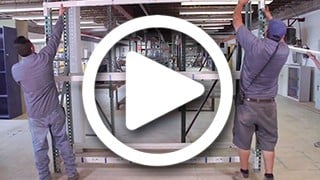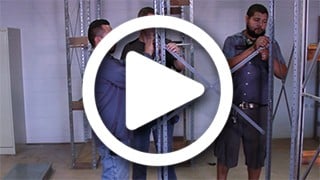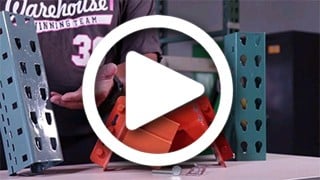Choosing the Right Pallet Racking System: A Complete Guide for Warehouse Managers
 Efficient storage is at the core of every productive warehouse. With various pallet racking systems available, selecting the best one for your operation can feel overwhelming. Each system comes with different strengths, limitations, and space requirements.
Efficient storage is at the core of every productive warehouse. With various pallet racking systems available, selecting the best one for your operation can feel overwhelming. Each system comes with different strengths, limitations, and space requirements.
At Warehouse1, we help warehouse managers and professionals like you design smarter storage strategies that reduce costs and improve productivity. This guide will walk you through the essentials, from evaluating your inventory needs to understanding the differences between selective, push-back, and drive-in racking systems.
What Is a Pallet Racking System?
 A pallet racking system is a storage solution designed to hold palletized goods on multiple horizontal levels. It allows you to maximize vertical space, streamline inventory access, and organize your warehouse floor more efficiently.
A pallet racking system is a storage solution designed to hold palletized goods on multiple horizontal levels. It allows you to maximize vertical space, streamline inventory access, and organize your warehouse floor more efficiently.
By implementing the right racking system, you improve order picking, maintain inventory accuracy, and optimize overall warehouse flow.
Why Your Choice of Racking System Matters
The racking system you choose has a direct impact on operational efficiency and safety. A poorly matched system can cause workflow delays, damage to products, forklift congestion, and even regulatory violations.
The right system provides easy access to products, improves employee productivity, and ensures long-term flexibility. It also helps you comply with safety codes and supports scalable growth as your business evolves.
Key Factors to Consider Before You Buy
Warehouse Layout and Ceiling Height
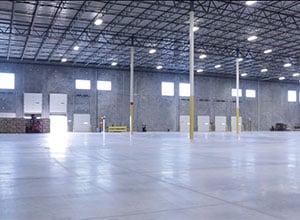 Measure your warehouse’s usable space. Include vertical clearance, column spacing, door placement, and any obstacles like HVAC units or lighting fixtures.
Measure your warehouse’s usable space. Include vertical clearance, column spacing, door placement, and any obstacles like HVAC units or lighting fixtures.
The layout of your building will influence the type and configuration of the racking system. Accurate facility drawings or CAD layouts are highly recommended during planning.
Storage Needs and Inventory Type
Start by reviewing the variety and volume of SKUs in your facility. High-turnover inventory benefits from quick-access systems like selective racking, while slower-moving stock may work better in high-density solutions.
Evaluate how frequently pallets are picked and restocked. Identify whether your inventory follows a first-in, first-out or last-in, first-out flow.
Forklift Compatibility
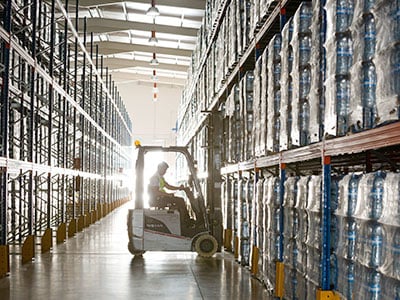 Verify that your material handling equipment matches your racking system. Consider aisle width, reach height, and turning radius.
Verify that your material handling equipment matches your racking system. Consider aisle width, reach height, and turning radius.
Some systems, such as pallet flow or drive-in racking, require specific forklifts like narrow aisle or deep-reach models to operate safely and efficiently.
Budget and Maintenance
Beyond the initial purchase price, consider long-term operating costs. Maintenance, repairs, part replacement, and reconfiguration should all be factored into your decision.
Used racking may lower upfront costs but could increase maintenance needs. Choose a system that balances affordability with performance over time.
Overview of Common Types of Pallet Racking
Selective Pallet Racks
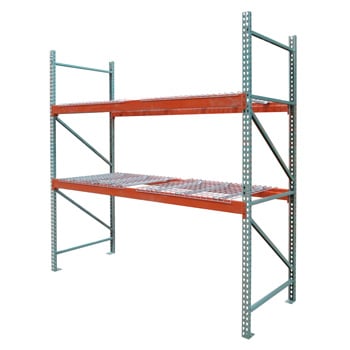 Selective pallet racks are the most widely used. They provide direct access to each pallet and are perfect for operations with diverse product lines.
Selective pallet racks are the most widely used. They provide direct access to each pallet and are perfect for operations with diverse product lines.
This system is easy to install, simple to reconfigure, and works well for first-in, first-out storage environments.
Push Back Racks
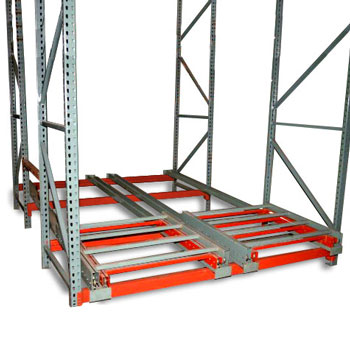 Push-back racks store pallets on carts that roll on slightly inclined rails. Each time a pallet is removed, the next one automatically rolls forward.
Push-back racks store pallets on carts that roll on slightly inclined rails. Each time a pallet is removed, the next one automatically rolls forward.
These racks are ideal for medium-turnover inventory and follow a last-in, first-out system. They offer excellent storage density without sacrificing too much access.
Drive-In and Drive-Thru Racks
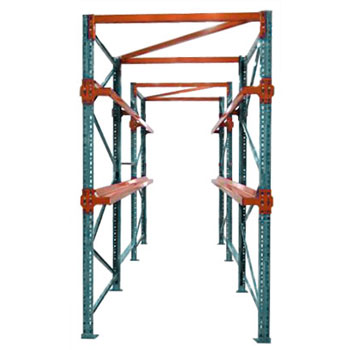 These systems allow forklifts to enter the rack structure. Drive-in racks provide single-entry access and follow a last-in, first-out sequence. Drive-thru racks allow two-sided access for first-in, first-out storage.
These systems allow forklifts to enter the rack structure. Drive-in racks provide single-entry access and follow a last-in, first-out sequence. Drive-thru racks allow two-sided access for first-in, first-out storage.
They are well suited for storing large quantities of the same SKU and help maximize cube utilization in your warehouse.
Pallet Flow Racks
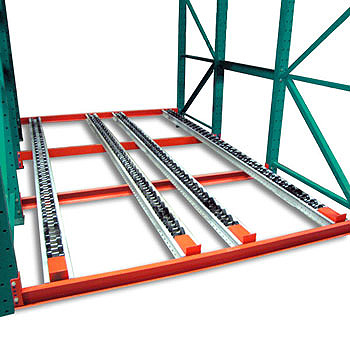 Pallet flow racks use gravity-powered rollers to move pallets from the loading side to the picking side. These racks support a first-in, first-out method and are ideal for perishable or high-turnover inventory.
Pallet flow racks use gravity-powered rollers to move pallets from the loading side to the picking side. These racks support a first-in, first-out method and are ideal for perishable or high-turnover inventory.
The system requires precise setup and is best for environments where consistent stock rotation is essential.
Cantilever Racks
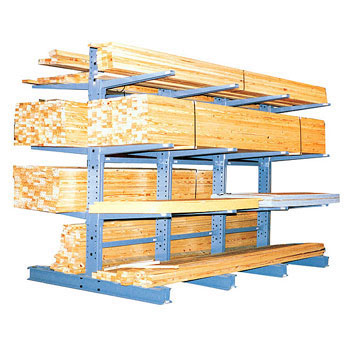 Cantilever racks are designed for long, bulky items such as lumber, pipes, or furniture. They use arms that extend from a central column and do not have front vertical posts, making loading and unloading easier.
Cantilever racks are designed for long, bulky items such as lumber, pipes, or furniture. They use arms that extend from a central column and do not have front vertical posts, making loading and unloading easier.
These racks are not designed for standard pallet loads but are essential for specific industries such as construction and manufacturing.
Pallet Racking Safety and Compliance Standards
OSHA Requirements and Capacity Labels
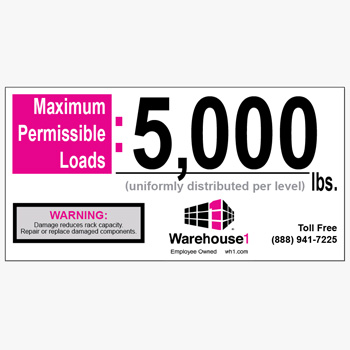 Safety and compliance should never be overlooked. Racking systems must have visible load capacity signage and comply with OSHA regulations.
Safety and compliance should never be overlooked. Racking systems must have visible load capacity signage and comply with OSHA regulations.
Warehouses are responsible for conducting routine inspections and ensuring that racking is properly anchored and free from damage.
Engineering and Permitting Considerations
Many municipalities require permits for new racking installations. These projects often need professionally engineered and stamped drawings to ensure structural safety.
Warehouse1 provides permitting assistance and engineering support to ensure your project stays compliant and moves forward without delays.
Planning for the Future: Scalability and Growth
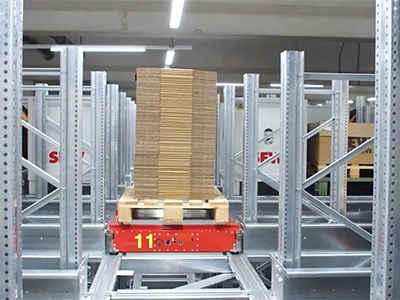 Choosing a pallet racking system isn’t just about solving today’s storage challenges—it’s about preparing for what’s next. As your operations expand, your storage solution should be able to scale with you.
Choosing a pallet racking system isn’t just about solving today’s storage challenges—it’s about preparing for what’s next. As your operations expand, your storage solution should be able to scale with you.
Think about where your business will be in three to five years. Will you be managing more SKUs? Higher volumes? Faster order fulfillment expectations? The system you select now should support future add-ons, higher density storage, or layout reconfigurations with minimal disruption.
At a certain point of growth, especially when labor or space constraints become limiting factors, it may be time to explore automated pallet racking systems, such as pallet shuttle systems. These systems can dramatically increase throughput and storage density by reducing aisle requirements and automating pallet handling within the rack.
Consider looking into automation when:
- You're consistently facing space limitations despite vertical optimization
- Labor availability is impacting your ability to meet demand
- Inventory turnover is high and speed-to-pick is becoming critical
- You’re operating in a temperature-controlled environment where time and energy use must be minimized
Planning ahead with automation in mind can help you avoid costly redesigns and set the stage for long-term efficiency gains.
How Warehouse1 Can Help You Make the Right Choice
At Warehouse1, we do more than sell pallet racking. We provide full-service warehouse design, equipment sourcing, and installation support to ensure your storage system fits your operational goals.
Our team helps you:
- Analyze your layout and SKU velocity
- Create CAD drawings for optimal design
- Source new or used racking systems
- Manage permitting and installation
We are a 100 percent employee-owned company with over 37 years of experience in warehouse and automated solutions. Our focus is on partnership, results, and building smarter storage systems that grow with your business.
Ready to Maximize Your Warehouse Efficiency?
Contact our team today for a free consultation and let us help you select the right pallet racking system for your space, budget, and future plans.
